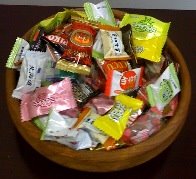
There are few things that say great candy like a cartoon of a snorkeling dog. And this dog has quite a lot to say about this candy from Kasugai.
There are four flavors of this unusual boiled sweet: grape, lemon, pineapple, and strawberry. Candybowl had the strawberry.
The initial taste impression is artificial, slightly cloying strawberry flavor. It has a pleasant sourness on the tongue that intensifies as the candy is sucked. The shell is rough, beckoning you, dear eater, to the sugary rocks.
The crunch is the game changer. Out pours a sour, fizzy center, bathing the mouth in candy delight. Bicarbonate is among the ingredients, and Candybowl surmises it combines with the sour shell to create fizz.
Candybowl recalls that when he was a child there were candies that might have been called Zingers. They came in a long chain of individually wrapped candies. Candybowl was not allowed to have them. But did have a chance to taste one or two, and recalls that the inside kind of sizzled. Not pop rock explosions, just a shimmery sizzly happening in your mouth.
Like that.






























